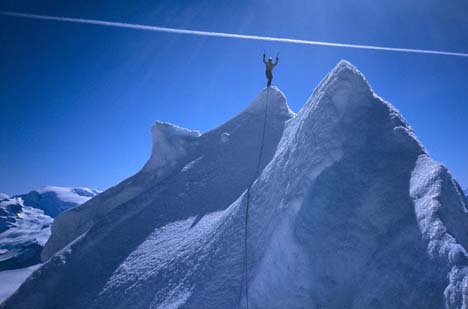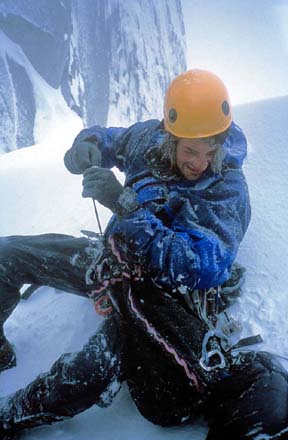Talking About Progression
- January 2008
- Training Uncategorized

Hi Steph. I met you very briefly at The Front climbing gym in SLC last winter during the OR trade show and just happened to find your website today while surfing the net. I purchased and read your book over the summer and loved it and of course found it inspiring and motivational. Since you seem so open to questions and seem to answer and update your blog regularly I thought I’d send my most relevant question your way.
What I’m wondering is how you take climbing to the next level in terms of becoming proficient and more of an expert.
I work as a mountain guide and rock and alpine climb as much as possible in my free time and i’m wondering if the next leap is more of a mental commitment to the lifestyle of a climber rather than that of the more typical secure lifestyle. I know the answer is obviously to climb more but was it more than that in your situation? I’m also about to go to Patagonia for the first time and I think I might be getting in over my head because i’m not the fastest leader and not so good at routefinding. How have you had the confidence to climb the peaks down there? Anyways, your website is great and i think that you are inspiration for female rock climbers/alpinists like myself. Thanks. Rachel Greenberg
Dear Rachel,
Thanks for the nice words! I’m so glad you liked my book and found some inspiration there. Thank you! 🙂
I have to admit, I’m a little puzzled by the idea of what is more of a climber-lifestyle commitment for you, since you are already living a pretty nontraditional lifestyle as a mountain guide, and heading down to Patagonia for the winter! It sounds like you are going for it already…..?! But your question about mental commitment, and taking it to the next level, does make me think about a lot of different things.
For me, climbing has always been a very progressive experience, rather than some sudden breakthrough. Whenever I’ve found myself at a new level, it has happened because I got excited about a big project that was harder than anything I’d done before–whether an alpine goal, or a big wall or free climbing goal. When I’ve been seized by inspiration to take on something that is actually beyond my ability, I’ve been forced to rise to a new level, in order to reach that goal. Then I find that along the way of that progression, my overall ability has increased as well, naturally. So this is really a fun question you’ve asked, because I can see that you are doing the same thing…..because you also said that you are headed down to Patagonia, and are feeling like you are taking on something bigger than you have done in the past. So I think you are doing it exactly right, as far as I can tell! The way to get better is to constantly push yourself, and take on a little more than you think you can do. Then you will have to rise to the occasion.
Don’t worry about getting in over your head on your trip. Patagonia is a funny place….it is so stormy and hard to get started on routes, that people tend to have lots of epics and retreats, but rarely get into serious (death) trouble. So you might have a few epics or nasty descents or bivvies or glacier crossings, but it will be very good experience for you!
There are also a few things you can do, if you are slow leading. Leading faster is the hardest thing to do, and can take years to achieve. But the good news is that on big routes, there are a lot of ways to be fast, without having to lead faster. Everything else can be sped up. When following, if the second is free climbing, that person should climb as fast as possible. On toprope, it doesn’t matter at all if the second falls. So the second should climb like a maniac, to the point of exhaustion even, because there will be time to rest at the belay.

If the second is jugging, Yosemite style, that person should jug as fast as possible. Even if you are short fixing, there will probably be a small bit of time to rest at the next belay, so put the hammer down and go like crazy. This can shave minutes off of each pitch, and does not require the leader to be rushed and risk making mistakes.

Also, think about maximum efficiency at belays. If the second racks the gear in order on a shoulder sling as he/she cleans, changeover time at the next belay will be decreased. By being ultra-organized and speeding up the changeovers, you can save several minutes as well. So if you save five minutes on a pitch with a faster second, and you save five minutes on the same pitch with a faster changeover at the belay, that’s ten minutes you saved on that pitch. On a ten pitch route, that adds up to an hour and forty minutes, which is pretty significant–and the leader never had to rush.
Another time saver is for the second to get ready to leave the belay before the leader has made the next anchor. It should be pretty obvious when the leader is close to the end of a pitch. About five minutes before the leader stops to make a new belay, the second should already be totally organized and ready to start climbing or jugging–shoes on, bars eaten, clothing tucked in and zipped, pack on. The second can also strip most of the anchor at this time–especially the nuts, leaving in an easy-to-remove cam, or just a biner on fixed slings–even before the leader has reached or made the next one, since the leader should have a whole pitch’s worth of pieces in by then. This can also save five minutes leaving the belay…..so on your ten pitch route, that’s another fifty minutes of time savings. So now we’re up to two and a half hours of time savings, and the leader never had to climb faster…..
The leading is the one thing it’s hard to rush. There are a few things the leader can think about though, like not setting nuts too hard, and trying to reduce the amount of gear placed. This will make it faster for the second.
Especially don’t try to rush yourself with route finding, because that often gets you off route, and then it takes even longer to get back on. Typically on alpine routes, it’s pretty easy to stay on route. For years I’ve used the trick, when climbing standard routes, of looking up and asking myself, “where would I go if I were the first ascensionist? The path of least resistance!” The path of least resistance is usually pretty obvious, and it’s almost always the right way on standard alpine routes. Double check your topo, but nine times out of ten, that will work. This is also very good training for you for when you are actually doing your own first ascent, so you should always be thinking this way.
The best advice I can give for Patagonia climbing, is never hurry on the descents. At that point, you’ve reached the summit (hopefully!), or else you are bailing.

Either way, there is no rush. It will take as long as it takes. Even if it’s a horrible storm, you just have to grit your teeth, dull your mind, and stay methodical and safe. I have pulled out many fixed pins in rappel anchors with my hand. Always use your ice hammer to smash on fixed pins before you trust an old rap anchor. Don’t worry about rapping on single biners when you see them on fixed anchors–that is traditional Patagonia method. But make sure to check the slings, and don’t be stingy with adding more slings or cutting off pieces of your rap line to add to old ones. Most deaths that have occurred in Patagonia have been because of bad anchors–pulled pins or broken slings. Take your time and make sure every anchor is good…..you will be cold and wet, but eventually you will get down and you will be warm again 🙂
Have an amazing trip. I know you will do great. Drink lots of mate–it’s full of magnesium and potassium!
xx Steph








Thanks so much. Those tips are confidence inspiring!
[…] … article marketing news – Last Updated – Thursday February 7 Request a Trackback Talking About Progression Hi Steph. I met you very briefly at The Front climbing gym in SLC last winter during the OR trade […]